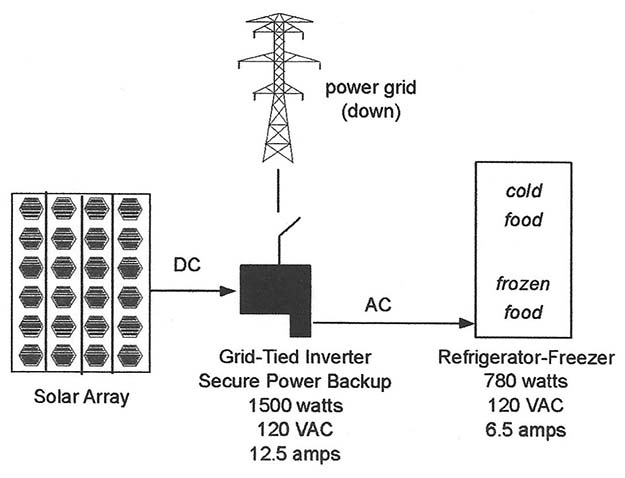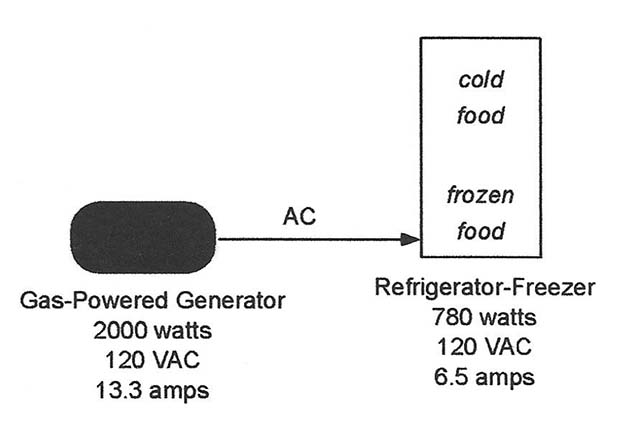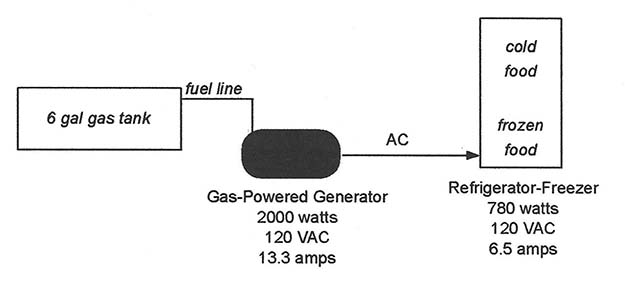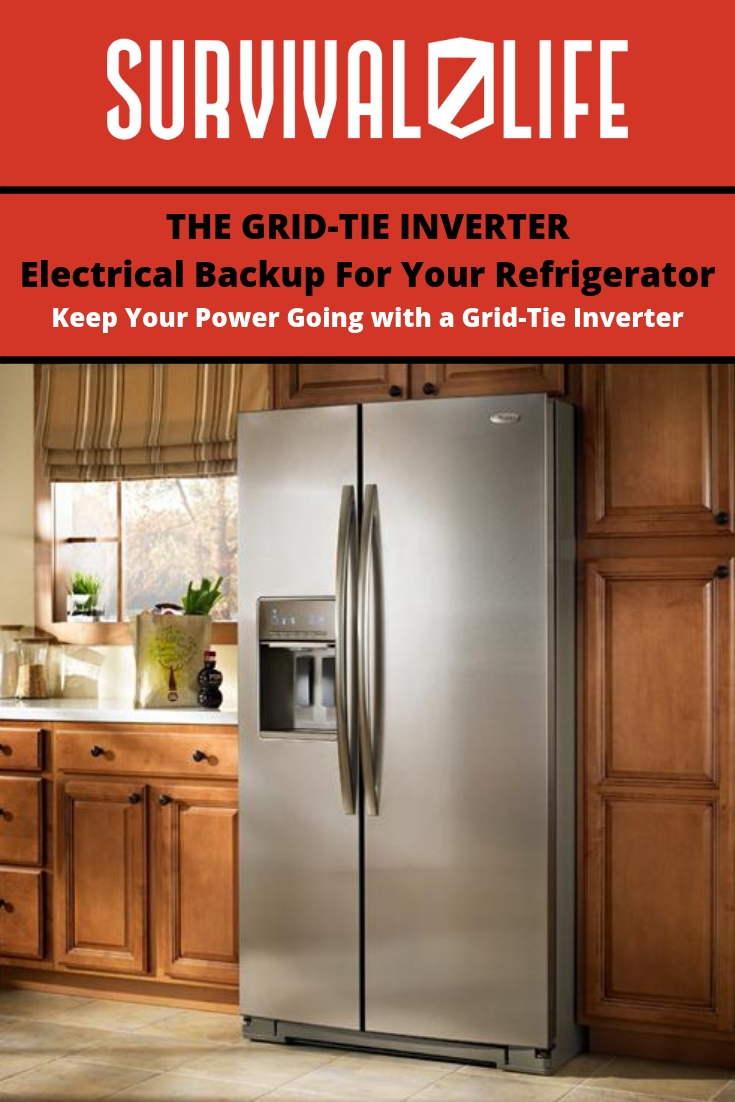Alternative Energy
The Grid-Tie Inverter: Electrical Backup For Your Refrigerator-Freezer

Know more about the grid-tie inverter and how to help keep your food fresh longer in case of a widespread or long-term power outage!
RELATED: Emergency Lighting | How Long Will That Bulb Last?
Keep Your Power Going with a Grid-Tie Inverter
Grid-Tie Inventer DIY: A Practical Power Solution
In case of a power outage, it’s absolutely essential to have a source of backup electricity. This grid-tie inverter is an excellent alternative to backup generators and solar power.
My greatest challenge for power-out backup electricity has been how to keep the side-by-side refrigerator-freezer in my kitchen going after the grid goes out. The issue is how to produce 6.5 Amps of 120VAC for the appliance on a 24/7 basis.
I’ve looked at a number of possible solutions and each has an associated cost-benefit. A solar panel works only when the sun is shining.
Deep cycle batteries need ventilation and monitoring for safety. This means vacation trips would be short or someone staying in my home to check battery condition.
Backup generators need fuel to operate. And I don’t have enough wind or hydro resources in this area to produce enough electricity for the application.
The solution? A grid-tie power inverter. So how does a grid-tie inverter work? Keep on reading for the answer.
Get the Coolest Light You’ve Ever Seen Right Now FREE!
Grid-Tie Inverter Working Principle
- Fig. 1 – Inverter with 1500W backup socket.
After studying the situation while gradually building up my backup resources, I found a way to solve my problem. Or at least mitigate it to a manageable level.
I have solar power and use the new Sunny Boy 3800TL-US SMA grid-tie inverter with the secure AC electrical backup socket as shown in Figure 1. The actual socket connection is in the lower right of the photo.
This grid-tie inverter produces 1500 watts of 120 volts AC and can provide 12.5 amps if grid power goes out and the sun is still shining.
I need 6.5 amps even though the refrigerator-freezer operates on a 20% duty cycle (draws 6.5 amps 20 percent of the time when the compressor is running). This is so the secure power from the grid-tie inverter works just fine during sunny days.
Figure 2 shows the configuration chosen for this application.

- Fig. 2 – Configuration providing 120VAC backup from a solar array.
RELATED: How To Revive Car Batteries: Don’t Throw Dead Batteries Just Yet
The Portable Generator
- Fig. 3 – Gasoline-powered electric generator.
Since a solar day here is about 7 hours long, I need another way to produce electricity for the 17 hours my solar panels aren’t producing power. I decided to use a Honda 2000i portable generator (Figure 3).
The 2000i has several external power sockets and can produce 13.7 amps of 120VAC using unleaded gas.
The 1-gallon gas tank in the 2000i can keep the generator going for about 5 hours – 9.6 hours if the economy burn rate is selected (Figure 4). It’s been quite dependable – and quiet.

- Fig. 4 – Generator providing 120VAC to the refrigerator-freezer.
When I connect a 6-gallon marine gas tank to the 2000i (Figure 5), I have a power system fueled by a 7-gallon tank. It can drive the generator for between 35 and 65 continuous hours—normal setting or economy setting.
There are ways to connect multiple 6-gallon gas tanks, but this single tank design is essentially all I need to provide 24/7 backup. It also gives me a comfortable feeling my food will be kept cold or frozen all through the power outage.
Generator with Expanded Fuel Storage

- Fig. 5 – Generator with expanded fuel storage for up to 65 hours of 120VAC.
During my operational tests of this design, the inverter secure power supply and the gas generator worked just fine. Except for the time to disconnect from the SMA inverter and plug the refrigerator-freezer into a power cord from the Honda 2000i generator, I experienced no downtime of significance.
This design can easily run for the three-days or indefinitely by refilling the marine gas tank periodically while the sun-driven SMA inverter was providing power. Refrigeration was a major concern for me, and this configuration met the challenge nicely.
This video from Average Joe will show you how to hook up a 600W solar grid-tie micro MPPT inverter:
A widespread power outage could likely disrupt the societal function across the board including food distribution. In times like this, you want the food stored in your refrigerator longer.
Different power source or alternative including this grid-tie inverter thus proves essential. Test one today and be always prepared in case of an emergency.
What do you think of the grid-tie inverter? Will you consider this alternative power source? Tell us your thoughts about it in the comments section below!
Up Next:
- Off the Grid Living: Straw and Ice Make Good Refrigeration
- What Causes a Power Outage?
- Choosing a Power Generator
If you’re looking for useful survival gear that you can’t make at home, check out the Survival Life Store!
Follow us on Facebook, Instagram, Twitter, Pinterest, and Tumblr!
***Disclaimer: The contents of this article are for informational purposes only. Please read our full disclaimer.***

Editor’s Note: This post was originally published on March 8, 2016, and has been updated for quality and relevancy.
-

 Do It Yourself7 months ago
Do It Yourself7 months agoParacord Projects | 36 Cool Paracord Ideas For Your Paracord Survival Projects
-

 Do It Yourself9 months ago
Do It Yourself9 months agoHow To Make Paracord Survival Bracelets | DIY Survival Prepping
-

 Do It Yourself9 months ago
Do It Yourself9 months ago21 Home Remedies For Toothache Pain Relief
-

 Do It Yourself10 months ago
Do It Yourself10 months agoSurvival DIY: How To Melt Aluminum Cans For Casting
-

 Exports8 months ago
Exports8 months agoAre Switchblades Legal? Knife Laws By State









Pingback: Electrical Backup for a Gas Furnace | Survival Life
Robert Trail
August 10, 2019 at 7:19 AM
One thing not mentioned here is that the power produced by most inexpensive inverters is modified sine wave, not pure sine wave alternating current. newer appliances like compressor motors don’t like the choppy power of modified sine wave and will suffer damage, shorten life, or die quickly. Ours failed months after we used the method I show below.
I also got rid of our generator, not just because of the inverter, but the NOISE. In a widespread outage it will be very quiet out there…after a week people will home in on the sound, looking for food. Desperate people can be very difficult, especially the ones who don’t have the common sense to prepare.
Here in Florida we are blessed with abundant sunshine so solar panels are the way to go but most installations are grid tied so they are in the same predicament as everyone else unless they have battery backup or alternate sources of power. My panels are useless during outages and until I can afford the battery bank I’ll depend on a small portable solar system that produces 2000 watts (a 20 amp circuit) with a modest battery backup. These are somewhat expensive and may not have pure sine wave.
So here’s what y’all can do: Go to Amazon or some other source and find a pure wave inverter of 2000 watts or more that uses 12 volts. This can be hooked up to your car battery and you will have the power to run your fridge and a few other things like the TV and lights so you can know what is going on. To avoid running your battery down (which will be rather quickly) You run your car just a bit over idle, enough to generate positive power to the battery-inverter setup.
You can adjust this by putting a suitable stick between the seat and accelerator and adjusting the seat position until it is just right..The advantage of this is not only economy but silence.
You don’t need to run this continuously, an hour every three should do.
For you unfortunates who live in the cold, don’t forget that the only thing keeping your oil burner from sending warmth is a small amount of power to run the ignition and pumps, the heat comes from the fuel. Heat pumps are more greedy and this isn’t realistic for them.
So go and get an inverter, a HEAVY extension cord, and a bunch of gas jugs and be sure to try it out right away, before you need it.
Robert Trail
August 10, 2019 at 7:34 AM
For those of you savvy with electricity you might do this: FLIP THE MAIN BREAKER TO OFF to isolate your power panel from the grid (you don’t want energy going out the grid causing injury to linemen), open the breaker box and flip all the breakers to off. Now connect the leads from the inverter to the main busses (if you don’t know what this means, you aren’t qualified to do this). Now all you need to do is switch on the circuits you wish to power and you don’t need that long extension cord and replugging all the time.
It is IMPERATIVE that you disconnect before switching the main breaker back on!
Pingback: Electrical Backup For A Gas Furnace – The Self-Sufficient Life
Pingback: Electrical Backup For A Gas Furnace – surviveurself
Pingback: Electrical Backup For A Gas Furnace – Survival Blog